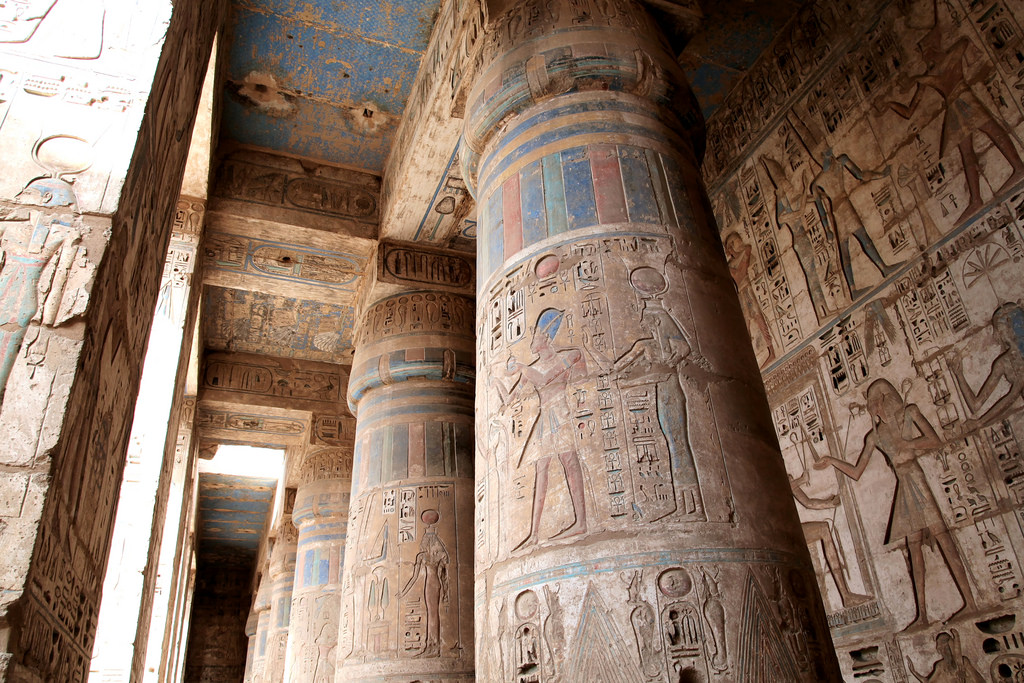By: Abdelrahman Amr and Michael Matthiesen.
In the first part in an Egyptian Streets article series under the name of East-West Chitchat that aims to spark increased dialogue between Americans and Egyptians, Abdelrahman Amr and Michael Matthiesen explore personal experiences of Egyptian history through visits to the Egyptian Museum in Cairo’s Tahrir Square and the Metropolitan Museum of Art in New York.
I had only six hours until my trip back to New York City from Cairo. After a week of meetings, little sleep, and being bused around the boroughs of Cairo, my fellows and I were ready to go. Yet, I was excited that we were scratching off the Cairo Museum before catching our plane.
To Americans, Egypt is the land of pharaohs, gods, and Moses. To Egyptologists, history and the ripple of civilization started with this great ancient culture, and all we have today begins with them.
Considering how much the Bible and elementary school textbooks talk about Egypt, seeing the relics, pyramids, and hieroglyphics can be both a historic and religious experience.
As the bus pulled up from Tahrir Square, I gazed at the Cairo Museum. I remember at seven years old, I saw the Temple of Dendur at The Metropolitan Museum – or The Met – and recalled all the stories I had read about it, including Ra, the pharaohs, and Moses. The Metropolitan Museum was my first time encountering a glance of Egypt, but I anticipated the Cairo Museum would top the Met. One of my Egyptologist friends raved about the relics in the Cairo Museum and how there were none else like them in the world. I was excited.
The one exception was the King Tut exhibit. Walking in felt like I stepped into legend. Staring at King Tut’s Mask was like looking at the Mona Lisa, The Statue of David, or the Sistine Chapel. It is a moment I will remember forever, and it finally topped the feeling I had seeing the Temple of Dendur at the Met. It’s the biggest impact the Cairo Museum made on me all day, and I was sad I had to step back into the dust.
While The Museum of Egyptian Antiquities – known as the Egyptian Museum in Cairo – houses the world’s most exquisite and extensive collection of ancient Egyptian artifacts, covering more than 3,000 years, walking through empty exhibits discourages anyone to proceed with the visit.
This was the Cairo Museum’s chance to show me how America and Egypt are tied. I had heard from Egyptians all week about how the US Senate wanted to cut aid to Egypt, and how I had a responsibility to stop it. Other than the pyramids, and King Tut’s exhibit, nothing motivated me to call my Senator for Egypt. Every American will see an Egyptian exhibit in their life, even if they don’t see the Cairo Museum. These exhibits are Egypt’s chance to influence Americans and other foreigners. If all of them are like the Cairo Museum, then what’s the point?

The Egyptian Museum in Cairo was established more than a hundred years ago and has about 120,000 items. Overall, according to Egypt’s official statistics body the Central Agency for Public Mobilization and Statistics (CAPMAS), the number of visitors to all 66 art and history museums in the country, including the Egyptian Museum, reached 3.2 million in 2015-2016 compared to 4.3 million in 2014.
Visiting Egypt’s most famous museum is more than enough to discourage you from visiting any other museums in the country.
I have visited a few museums in Europe including the Louvre in Paris and was always amazed by how a visit to the museum can actually be enjoyable. This broke my heart as I have made an unintentional comparison between the museums I have visited abroad and the Egyptian Museum in my country. This disappointment was magnified when I visited the Egyptian section in the Metropolitan Museum of Art one month after visiting the Egyptian museum; a visit that assured me how Egyptian museums are still behind the times.
At first, I was amused by the vast space of the museum. The Egyptian section alone was, at least, as big as the whole Egyptian museum, if not bigger. Sadly, I was making comparisons at every step I took after grasping how the way an object being displayed can shape a one of a kind connection between it and between the audience experiencing it firsthand. As a visitor, I surely appreciated that the displays delivered a narrative or some sort of historical stories in regard to the ancient Egyptian civilization, how their noblemen and farmers lived, what tools they used, their cosmetics, the jewelry women used to wear, furniture in homes and so on.
Artifacts displayed were only a small amount of what Egypt is blessed with to the full and what you can find many of inside the famous Egyptian museum. Yet the point at issue here is not the objects themselves but the way they are being put on show. The Met managed to properly strike a wonderful balance between content and presentation.
To my surprise, the end of our tour included a temple that is inside the Egyptian section, the Dendur temple.

One other matter that I realized during my visit was how artifacts are divided according to sections that you can easily navigate through, taking you from the Paleolithic to the Roman period, again, something extremely simple and obvious yet neglected or not clear in the Egyptian museum.
On several occasions, I caught myself trying to find answers to basic questions in my head regarding actions that my country could make to allow for a better museum experience like proper signs, seating areas, and different facilities. I certainly noticed the presence of children and families inside the museum which made me realize how museums can be a great outing, something that has not been part of the culture of citizens of the country most famous for its history.
I think that by the end of your visit to the Egyptian section in the Metropolitan Museum, you can learn a lot about ancient Egypt, which can set off new perceptions about the history of one of the most important countries in the Middle East. This should be one of the results of any museum visit. However, Egypt is yet to take advantage of a huge cultural diplomacy opportunity making its heritage more enjoyable.
Despite all the mismanagement, I truly understand how hard it could be for the Ministry of Antiquities to operate the museum in such tough times for the tourism industry after the number of visitors fell drastically after the 2011 revolution. This, of course, led to lack of the needed financial resources for development. In 2015, the ministry’s budget fell from EGP 1.3 billion to EGP 125 million and it presumably relies entirely on self-financing through four projects for funding. Yet, the point is, funding can contribute to creating a better experience in one of the most important museums in the world if supported with the right management.
On the bright side, just two kilometers away from the Great Pyramids, construction is underway for the new Grand Egyptian Museum, which is expected to be the first of its kind in the country with top-notch facilities and presenting a better story. The new facility will have about 100,000 artifacts on display, 30,000 of which have never been shown to the public, including the complete Tutankhamun collection. After suffering problems with funding, in 2018 we might finally witness a new experience for Museums in Egypt that can hopefully spark dialogues and that will also give more space to the Egyptian Museum of Antiquities to develop.







Comment (1)
[…] Brooklyn Museum (readers may be interested in checking out this Egyptian Streets series, East-West Chitchat: Egyptian Museums Between Cairo and New York, in which an American and Egyptian author share personal experiences of Egyptian history through […]